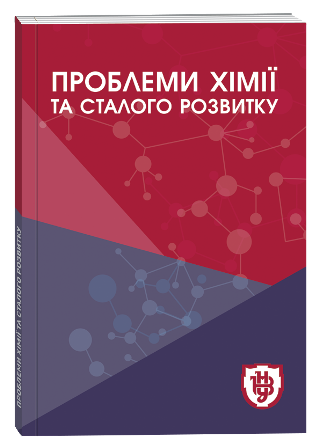СКЛОУТВОРЕННЯ В КВАЗІПОТРІЙНИХ СИСТЕМАХ AІ 2S–ВIVS2–СV 2S3 (АI – CU, AG; ВIV – GE, SN, СV – AS, SB)
DOI:
https://doi.org/10.32782/pcsd-2021-4-1Ключові слова:
квазіпотрійна система, фазова діаграма, халькогенід, область склоутворення, рентгенофазовий аналізАнотація
Уперше встановлено межі областей склоутворення у квазіпотрійних системах AІ 2S–ВIVS2–СV 2S3 (АI – Cu, Ag; ВIV – Ge, Sn, СV – As, Sb) на основі результатів рентгенофазового аналізу. Максимальна температура синтезу становила 1100 К із подальшим гартуванням ампул у 25-відсотковий водний розчин натрій хлориду з подрібненим льодом. Одержані склоподібні зразки становили темно-сірі та жовто-червоні блискучі монолітні сплави. У досліджуваних германійумісних системах АI 2S–GеS2–СV 2S3 наявні неперервні області склоутворення на сторонах GeS2–СV 2S3. Головним чинником є схильність GeS2, As2S3 та Sb2S3 до склоутворення. За перерізом Ag2S–GeS2 у склоподібному стані отримуємо зразки з умістом Ag2S від 0 до 55 мол.%. У квазібінарній системі Ag2S–As2S3 є область склоутворення в межах 0–70 мол.% Ag2S. Максимальний уміст модифікатора Cu2S, який удалося ввести за умов збереження склоподібного стану, становить 10 та 15 мол.% у системах Cu2S– GеS2–As(Sb)2S3 відповідно. Максимальний уміст Ag2S, що входить до складу скла в системах Ag2S–GеS2–As(Sb)2S3, становить 70 та 55 мол.% відповідно. У станумовмісних системах області склоутворення значно менші порівняно з аналогічними германійумісними, що пов’язано з посиленням йонного складника хімічного зв’язку в разі заміни GeS2 на SnS2. У квазіпотрійних системах Сu(Ag)2S–SnS2–Sb2S3 спостерігаємо лише дві області склоутворення, які розміщуються на стороні SnS2–Sb2S3: одна перебуває в області 17–23 мол.% Sb2S3, включно з 3 та 2 мол.% Cu2S, Ag2S відповідно, інша – 66–83 мол.% Sb2S3, максимальний уміст Cu2S та Ag2S становить 12 та 4 мол.%. У системі Сu2S– SnS2–As2S3 область склоутворення простягається від 76 до 100 мол.% As2S3, максимальний уміст Cu2S становить 12 мол.%. У системі Ag2S–SnS2–As2S3 за перерізом Ag2S–As2S3 у склоподібному стані є зразки в межах 0–75 мол.% Ag2S. На стороні SnS2–As2S3 концентраційного трикутника область склоутворення простягається від 78 до 100 мол.% As2S3.
Посилання
Шпотюк М.В. Фізичні особливості радіаційно-структурної модифікації ковалентно-сіткового скла As–S : дис. … док. фіз.-мат. наук : 01.04.07. Львів, 2018. 345 с.
Бабанлы М.Б., Юсибов Ю.А., Абишев В.Т. Трехкомпонентные халькогениды на основе меди и серебра. Баку : БГУ, 1993. 342 с.
Cho J.Y., Shi X., Salvador J.R., Meisner G.P., Yang J. et al. Thermoelectric properties and investigations of low thermal conductivity in Ga-doped Cu2GeSe3. Physical Review B. 2011. Vol. 84. № 8. Doi : 10.1103/PhysRevB.84.085207
Marcano G., Bracho D.B., Rincon C., Perez G.S., Nieves L. On the temperature dependence of the electrical and optical properties of Cu2GeSe3. Journal of Applied Physics. 2000. Vol. 88. P. 822–828.
Виноградова Г.З. Стеклообразование и фазовые равновесия в халькогенидных системах. Москва : Наука, 1984. 238 с.
Кевшин А.Г. Особливості структури халькогенідних стекол на базі GeX2 (X=S, Se). Фізика і хімія твердого тіла. 2014. Т. 15. № 4. С. 682–688.
Борисова З.У., Бычков Е.А., Тверьянович Ю.С. Взаимодействие металлов с халькогенидными стеклами : монография. Ленинград, 1991. 252 с.
Роусон Г. Неорганические стеклообразующие системы. Москва : Мир, 1970. 270 с.
Паюк О., Ліщинський І., Стронський О., Криськов Ц., Губанова А., Прібилова Г., Влочек М. Властивості стекол As2S3 легованих марганцем: калориметричні дослідження та Раманівська спектроскопія. Фізика і хімія твердого тіла. 2011. Т. 12. № 3. С. 594–597.
Flaschen S.S., Pearson A.D., Northover W.R. Low-melting inorganic glasses with high melt fluidities below 400°. J. Amer. Ceram. Soc. 1959. Vol. 42. № 9. P. 450.
Kamitsos E.I., Kapoutsis J.A., Chryssikos G.D., Taillades G., Pradel A., Ribes M. Structure and Optical Conductivity of Silver Thiogermanate Glasses. J. Solid State Chem. 1994. Vol. 112. № 2. P. 255–261. Doi : 10.1006/jssc.1994.1301.
El Mkami H., Deroide B., Zanchetta J.V., Rumori P., Abidi N. Electron paramagnetic resonance study of Mn2+ and Cu2+ spin probes in (Ag2S)x(GeS2)1–x glasses. J. Non-Cryst. Solids. 1996. Vol. 208. № 1–2. P. 21–28. Doi: 10.1016/S0022-3093(96)00509-1.
Борисова З.У. Халькогенидные полупроводниковые стекла. Ленинград : Ленингр. ун-т, 1983. 344 с.
Климович О.С., Змій О.Ф., Олексеюк І.Д. Фазові рівноваги та склоутворення в системі Cu2Se – SnSe2 – As2Se3. Наук вісн. СНУ імені Лесі Українки. Хімічні науки. 2013. № 23. С. 89–94.
Климович О.С., Змій О.Ф., Олексеюк І.Д. Cклоутворення в системі Cu2Se – GeSe2 –As2Se3. Наук. вісн. ВДУ імені Лесі Українки. Хімічні науки. 2007. № 15. С. 14–18.
Фунтиков В.А. К вопросу о строении стёкол и физико-химическом анализе стеклообразных систем. Физика и химия стекла. 1996. Вып. 22. № 3. С. 279–285.
Ковач С.К., Кохан A.П., Ворошилов Ю.В. Электрохимическое поведение Ag8GeS6 и Ag8GeSe6. Укр. хим. журн. 1993. Вып. 59. № 4. С. 396–398.
Кохан О.П. Взаємодія в системах Ag2X–BIVX2 (BIV–Si, Ge, Sn; X–S, Se) і властивості сполук ׃ автореф. дис. … канд. хім. наук : 02.00.01. Ужгород, 1996. 21 с.
Liu Jun, Videau J. J., Tanguy B., Portier J., Reau J. M. Investigation on glass in the As−Ag−S system. Mater. Res. Bull. 1988. Vol. 23. P. 1315–1320.







